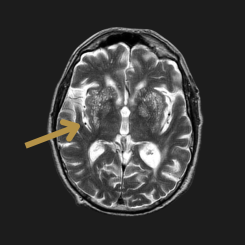Early Brain Changes Predict Functional Decline
Corey Bolton, PsyD, L. Taylor Davis, MD, Dandan Liu, PhD, Bennett Landman, PhD, Katherine Gifford, PsyD, Timothy Hohman, PhD, and Angela Jefferson, PhD
Using Vanderbilt Memory and Aging Project data, researchers found smaller grey matter volume and greater white matter hyperintensities at study entry predicted faster decline in the ability to complete complex tasks.
Grey matter throughout the nervous system enables individuals to control movement, memory, and emotions. White matter hyperintensities are white matter lesions in the brain, which have been associated with cognitive decline.
New Findings Related to Alzheimer's Genetic Risk Factor
Timothy Hohman, PhD, Logan Dumitrescu, PhD, Katherine Gifford, PsyD, and Angela Jefferson, PhD
A genetic variant of apolipoprotein E (APOE), a protein involved in fat metabolism, is the strongest common genetic risk factor for Alzheimer’s disease. However, many APOE-e4 carriers remain cognitively normal throughout life, suggesting there may be modifiers of APOE effects that protect the brain.
Arterial Stiffness May Impair Cognition
Angela Jefferson, PhD, Dandan Liu, PhD, Taylor Davis, MD, Bennett Landman, PhD, Katherine Gifford, PsyD, Timothy Hohman, PhD, and John Jeffrey Carr, MD.
New Biomarker Shows Promise
Rebecca L Winfree, Logan Dumitrescu, Katherine A Gifford, Kimberly R Pechman, Angela L Jefferson, Timothy J Hohman
New findings from the Vanderbilt Memory and Aging Project suggest sTREM2 (soluble Triggering Receptor Expressed on Myeloid Cells-2) has promise as a new biomarker of brain changes in people with Alzheimer’s disease. Biomarkers are measurable changes in the body that help determine if a person has a disease. The most well-known biomarkers of Alzheimer’s disease are amyloid beta and phosphorylated tau.



